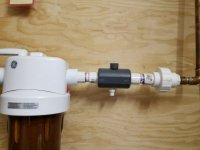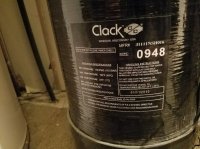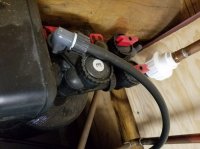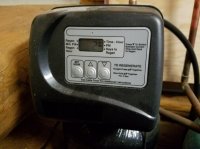In 2011 my brother purchased an iron filtration unit from a company named DFI/PEC in the Denver area. After he paid and took receipt, the company promptly went out of business without delivering any manuals or instructions. The unit has an air induction venturi, and he was told it was "maintenance free" without needing any reagents or treatment other than the programmed backwash. The receipt simply says "iron filter".
We installed the unit in our jointly owned cabin and it has worked excellently for 6 years (vacation cabin with periodic use). However, the filtration is becoming a bit less effective and some of the iron staining is returning. However, I don't know if this is greensand, Birm, or some other media. Is there any easy way to identify what the media is? Or alternatively, is there any chemical such as IronOut, potassium permanganate or other material that can be safely used without knowing the exact media that was incorporated?
I've enclosed photos of the Clack tank, the unbranded control panel, the air venturi. I do have easy capability to add a chemical at the sediment filter if there is something safe to try.




I'd greatly appreciate any reply on the best way to rejuvenate the media. If I need to disassemble and sample the media, I'd appreciate any links on how best to identify what it is.
Thanks in advance!
We installed the unit in our jointly owned cabin and it has worked excellently for 6 years (vacation cabin with periodic use). However, the filtration is becoming a bit less effective and some of the iron staining is returning. However, I don't know if this is greensand, Birm, or some other media. Is there any easy way to identify what the media is? Or alternatively, is there any chemical such as IronOut, potassium permanganate or other material that can be safely used without knowing the exact media that was incorporated?
I've enclosed photos of the Clack tank, the unbranded control panel, the air venturi. I do have easy capability to add a chemical at the sediment filter if there is something safe to try.




I'd greatly appreciate any reply on the best way to rejuvenate the media. If I need to disassemble and sample the media, I'd appreciate any links on how best to identify what it is.
Thanks in advance!
